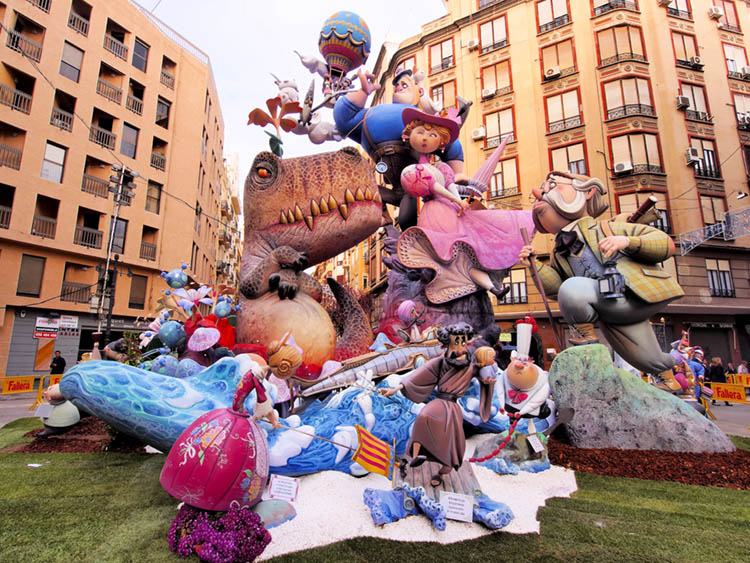Top image: A bonfire known as la Cremà consumes fallas and ninots on the last night of las Fallas in Valencia, Spain. Credit: © Jorgefontestad/iStockphoto
This week, the Spanish city of Valencia hosts one the world’s more unique holiday celebrations: las Fallas (or les Falles). In Valencia, a falla is a type of torch, and for the festival, artistic monuments (also called fallas) are built and ceremoniously burned in the streets. The fire festival of las Fallas celebrates the coming of spring, lasting several days before culminating on the feast day of San José (Saint Joseph), March 19.
Las Fallas dates back to the Middle Ages when each spring (when fires were no longer needed for light and warmth) carpenters burned spare wood outside their shops in Valencia. Over time, decorative additions were added to the spare wood, and the burnings took on a competitive and celebratory nature. The Roman Catholic Church combined this springtime custom with the feast day of Saint Joseph, the patron saint of carpenters.

Fallas and ninots can be quite elaborate and take months to plan and build. Fires then destroy them in minutes. Credit: © Karol Kozlowski, Shutterstock
Fallas can be quite large and are made of such materials as wood, cardboard, and papier-mâché. To accelerate the burn and add some “pop,” they are often stuffed with firecrackers or other combustibles. In Valencia, each neighborhood comes together to create its own falla. The fallas consist of themed scenes that include ninots (puppets) that represent cultural, political, or religious figures (often critical or satirical in nature). The fallas are paraded through the streets and awards are given for the most creative and decorative ones. The fallas (which also means defects or faults in Spanish) then go up in flames as symbolic acts of purification. Despite the short life spans of the fallas and their ninots (a few are preserved in Valencia’s Museo Fallero), great care and pride go into their creation. Falleros, the artists who create the fallas, are highly regarded.
People often dress in historical and traditional costumes for las Fallas, and they crowd the streets of Valencia throughout the festival. The noise of firecrackers and fireworks follows musical parades each day, culminating with the grand Cavalcada de Foc (Fire Parade) on the evening of March 19. Late on the fiesta’s final night, the fallas are burned in a huge bonfire known as la Cremà. Attentive firefighters stand by throughout las Fallas, dousing stray flames and spraying water on nearby structures to prevent them from catching fire. Similar holidays known as the Hogueras de San Juan (Bonfires of Saint John) are held in Alicante and other Spanish towns to mark the summer solstice.
In 2016, the United Nations Educational, Scientific and Cultural Organization (UNESCO) added las Fallas to the Representative List of the Intangible Cultural Heritage of Humanity. This list aims to safeguard important cultural traditions, such as storytelling, performing arts, social practices, rituals, festive events, knowledge and practices concerning nature and the universe, and the knowledge and skills to produce traditional crafts.
Untitled Document Can't view the linked articles? Subscribe to World Book Online

World Book Online delivers a progressive sequence of core databases supported by supplemental
tools, such as language translation, graphic organizers, and unique Webquests. Moving from
Early World of Learning to World Book Advanced, World Book Online aligns end-users with their
appropriate learning levels. Each stand-alone site provides additional features to support the
needs of users’ specific capabilities.
The World Book Difference
World Book combines cutting-edge technology with traditional editorial excellence to produce
authoritative, trustworthy, and unbiased content. The digital content is updated in real time and
carefully curated for each learning level. Accessible 24/7, the content is available on a variety of devices.
World Book Online combines 21st-century instructional techniques with timely information.
By breaking down complex topics and using easily understandable text, World Book Online helps to
build fluency and increase comprehension. Featuring single sign-on capability, these sites are paired
with highly visual content to engage even the most reluctant reader. Our collection of resources kindles
a lifelong learning experience for every user. This adherence to clarity, currency, and accuracy makes
World Book’s digital offerings an information hub for the classroom, library, and beyond.